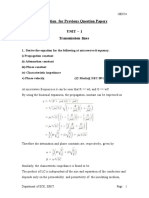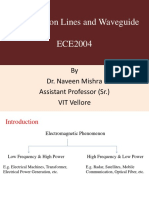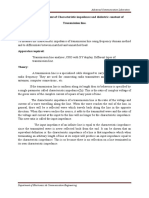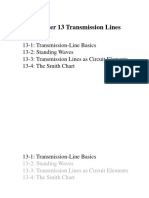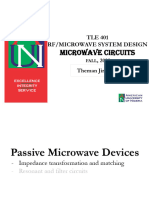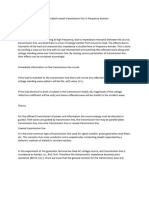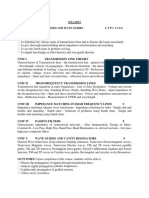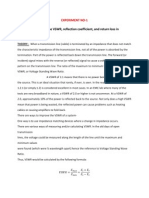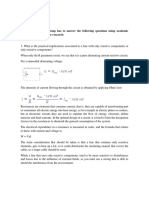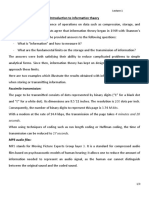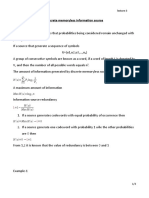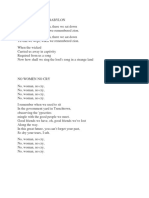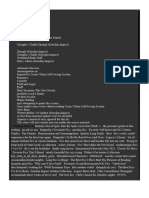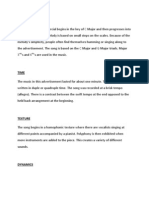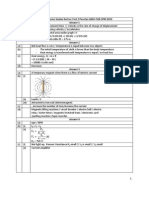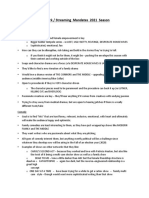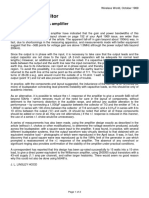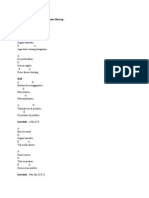Lecture 2
Lecture 2
Uploaded by
Mustafa KhiderCopyright:
Available Formats
Lecture 2
Lecture 2
Uploaded by
Mustafa KhiderOriginal Title
Copyright
Available Formats
Share this document
Did you find this document useful?
Is this content inappropriate?
Copyright:
Available Formats
Lecture 2
Lecture 2
Uploaded by
Mustafa KhiderCopyright:
Available Formats
Conventional Transmission lines
A transmission line is a two-conductor cable that can carry RF energy to other end. The
transmission line is used to connect transmitter to antenna or from antenna to transmitter.
There are two type of transmission line.
Balance line (parallel wire):
The balance line is a two parallel conductor separated by a continuous plastic insulate as shown in
Fig_1.1. In the wire line equal current flows in each conductor (wire) with respect to ground, but the
direction of current in two wires are out of phase with each other. No wire is connected to ground
Fig_1.1
Unbalance line (coaxial cable):
Unbalance line is called the coaxial line because there are two concentric conductors, the inner
conductor with diameter [d] and an outer conductor with diameter [D], the inner and outer conductor
are insulated as shown in fig_1.2. In unbalance line, the two conductor are at different potential where
the outer normally at ground potential.
Fig_1.2
Parameters of transmission line
There are some characteristic or parameters that must be known for the transmission line some are
- Velocity factor: Velocity factor is defined as a ratio of transmission speed in transmission line to
transmission in free space. It is denoted by VF
vl
VF=
vs
Where
vl =Transmission speed in transmission line; vs =Transmission speed in free space
Microwave Eng Lecture-2
The velocity factor in a line can be computed with the expression
1
VF=
√∈
Where, ϵ is the dielectric constant of the insulating material.
Example:
Find the transmission speed on a coaxial transmission line if the dielectric in a coaxial is Teflon with
dielectric constant equals 2.1.
Solution
1 1
VF= = =0.69
√ ϵ 1.45
That is, the speed of the signal in the coaxial is 0.69 times the speed of light, or
0.69x 300,000,000 = 207,000,000 m/s
- Characteristic impedance: When the length of the transmission line is longer than several
wavelengths at the signal frequency, the two parallel conductors appear as complex impedance known
as a characteristic impedance [ Z0], and the line appear as a distributed low pass filter shown in fig_1.3
Fig_1.3
The impedance can calculated with the expression
L
Z 0=
√ C
Ω
Where
L= inductance of transmission line in given length
C= capacitance of transmission line for the same length
The inductance and capacitance of the line depend on the physical characteristic of the line, so
practically the characteristic impedance is calculated from the dimensions of the transmission line
Microwave Eng Lecture-2
The expression for characteristic impedance of a parallel two wire transmission line is
2d
Z 0=276 log Ω
D
The expression for characteristic impedance of a coaxial line is
d
Z 0=138 log Ω
D
- Cable attenuation: Attenuation is the amount of power loss over the cable. The attenuation is
directly proportion to cable length and it is farther increase with frequency. The attenuation α in dB is
given by
Po
∝=10 log dB
Pi
Note: the loss always negative dB value
The following figure shows the Attenuation versus frequency for common coaxial cables.
- Standing wave Ratio: For proper operation and to be obtain maximum power at output,
transmission line must be matched terminated. Means, if the load impedance and characteristic
impedance matched maximum power transfer take place. Fig_1.4 shows a matched terminated 50Ω
Fig_1.4
Microwave Eng Lecture-2
When the load line is not perfectly matched with characteristic impedance of the line, all the
transmitted power will not be absorbed by the load, some part of the power will be reflected back. The
net output power is the algebraic sum of the forward and reflected signals and these signals form a
wave called standing wave. The standing wave is defined as a unique distribution of voltage and
current among a transmission line which is not terminated by the characteristic impedance
The magnitude of the standing wave is dependent on the maximum and minimum values of current or
voltage and is measured as standing wave ratio (SWR) given by
I max V max
SWR= =
I min V min
When open circuit and short circuited transmission line, the current and voltage minimum
value are zero i.e. Imin=Vmin=0 there for SWR is infinity
With proper termination line, there are no standing waves. The voltage and current are
constant SWR is unity
SWR can be calculated if the transmission line impedance and the load impedance are known, and
given by
ZL Z
SWR= ; if Z L > Z o ,else SWR= o
Zo ZL
Since the standing wave is really the composite of the original incident wave added to the reflected
wave, the SWR can also be defined in terms of those waves. The ratio of the reflected voltage wave Vr
to the incident voltage wave Vi is called the reflection coefficient (ᴦ)
Vr
Γ=
Vi
- If a line is terminated in its characteristic impedance, then there is no reflected
voltage, so Vr =0 and Γ= 0.
- If the line is open or shorted, then total reflection occurs. This means that Vr and Vi
are the same, so Γ= 1.
If the load is not matched and also not an open or short, the line will have voltage minima and maxima,
as described previously. These can be used to obtain the reflection coefficient by using the formula
Microwave Eng Lecture-2
V max−V min SWR−1 Z L−Z o
Γ= = =
V max +V min SWR +1 Z L + Z o
Example:
An RG-11/U foam coaxial cable has a maximum voltage standing wave of 52 V and
a minimum voltage of 17 V. Find
(a) the SWR
(b) the reflection coefficient
(c) the value of a resistive load.
solution
It is possible to compute reflected power Pr if given the SWR and the incident power Pi.
Since
Pr SWR−1 2
2
Γ =
Pi
= (
SWR +1 )
Example:
Find the ratio Pr/Pi for a transmission line of SWR=1.5
Solution
Microwave Eng Lecture-2
P r 1.5−1 2
Pi
=(1.5+1 )2
=0.2 =0.4=4 %
Knowing the SWR, you can compute Γ and then find Pi. The figure below shows the Percentage of
reflected power on a transmission line for different SWR values.
For SWR values of 2 or less, the reflected power is less than 10 percent, which means that 90 percent
gets to the load. For most applications this is acceptable. For SWR values higher than 2, the percentage
of reflected power increases dramatically, and measures must be taken to reduce the SWR to prevent
potential damage. The most common approach to reducing the SWR is to produce an impedance
match.
One of the best and most practical ways to compute the SWR is to measure the incident power Pi and
reflected power Pr and then use the formula
1+ √ Pr / Pi
SWR=
1√ P /P
r i
Microwave Eng Lecture-2
Impedance matching
Impedance matching circuit is inserted between the transmitter and the transmission line as shown in
Fig_1.5.
Fig_1.5
The matching circuit will make the transmitter behave properly. Common used impedance matching
circuits are: LC-network, L-network, T-network, π-network and transformers. Fig_1.6 shows L-Network
impedance matching circuits
Fig_1.6
To calculate the inductance and capacitance value the following formulas can be used
X L =√ R S R L−R2L ; R L<¿R else X L= √ R S R L− R2S ¿
S
RS RL
XC =
XL
Microwave Eng Lecture-2
Example
Match a 6 ohm transistor amplifier to a 50 ohm antenna load at 155 MHz.
Solution
RS<RL , So
X L =√ R s R L −R2s= √6 ( 50 ) −62= √246=16.25 ohm
R S R L 6 (50)
XC = = =18.46 ohm
XL 16.25
To find the values of inductor (L) and capacitor (C) at 155 MHz
1
X L =2 πfL , X C =
2 πfC
Microwave Eng Lecture-2
You might also like
- The Ethical SlutDocument185 pagesThe Ethical SlutAna Maria Matei92% (13)
- Q1 Q3 Q4 Ece123 PDFDocument23 pagesQ1 Q3 Q4 Ece123 PDFArthur Casimiro MapayeNo ratings yet
- Transmission Lines (Complete)Document14 pagesTransmission Lines (Complete)Floyd SampianoNo ratings yet
- Ece V Microwaves and Radar 10ec54 SolutionDocument77 pagesEce V Microwaves and Radar 10ec54 SolutionmansourvcxNo ratings yet
- W2&W3. Ch2.0 Transmission Line Theory v0.2Document74 pagesW2&W3. Ch2.0 Transmission Line Theory v0.2zetty_rashidNo ratings yet
- Transmission Lines-Basic Principles 01515900Document13 pagesTransmission Lines-Basic Principles 01515900Sachin1091No ratings yet
- 04-Dec-2019 Transmission LinesDocument93 pages04-Dec-2019 Transmission LinesAtul Wadhwa 18BEC0945No ratings yet
- Wideband TransformersDocument6 pagesWideband TransformersA. VillaNo ratings yet
- Resonance: University of Babylon Basic of Electrical Engineering Lecture NotesDocument25 pagesResonance: University of Babylon Basic of Electrical Engineering Lecture NotesSaad AlwashNo ratings yet
- Pulses in Cables: ReferencesDocument5 pagesPulses in Cables: ReferencesPaul DumitruNo ratings yet
- EC8651 TLW R2017 2 MarksDocument11 pagesEC8651 TLW R2017 2 Marksdhanaraj100% (2)
- Transmission LinesDocument109 pagesTransmission LinesJoshua RefeNo ratings yet
- Communication Electronics: Transmission LinesDocument35 pagesCommunication Electronics: Transmission LinesBahri AkgülNo ratings yet
- Performance of Transmission LinesDocument3 pagesPerformance of Transmission LinesJeremy DeleonNo ratings yet
- Ex No 9 Measurement of Characteristic Impedance and Dielectric Constant of Transmission LineDocument3 pagesEx No 9 Measurement of Characteristic Impedance and Dielectric Constant of Transmission LineJose DahlsonNo ratings yet
- Transmission LinesDocument114 pagesTransmission LinesRad Sison LagoNo ratings yet
- 5.performance of Transmission LinesDocument36 pages5.performance of Transmission LinesJerry MashmanNo ratings yet
- 5.performance of Transmission Lines-1Document36 pages5.performance of Transmission Lines-1Rume EmujekarohwoNo ratings yet
- Lec9 Microwave Network Analysis (I)Document21 pagesLec9 Microwave Network Analysis (I)Mohammed AbbasNo ratings yet
- Electromagnetic Theory Chapter 2 Transmission LinesDocument41 pagesElectromagnetic Theory Chapter 2 Transmission LinesRaymond Wen HuanNo ratings yet
- CHAPTER 1 Transmission LineDocument66 pagesCHAPTER 1 Transmission LineAyie ZulkhairieNo ratings yet
- Transmission Line,: ASCR (Aluminium Conductor Steel Reinforced) Are Used in This Type of Transmission LineDocument5 pagesTransmission Line,: ASCR (Aluminium Conductor Steel Reinforced) Are Used in This Type of Transmission Linemana danaNo ratings yet
- Translines ProjectDocument8 pagesTranslines ProjectOdellien SajaNo ratings yet
- CP 13Document43 pagesCP 13M Alwan Nur AjieNo ratings yet
- MW Lec-Scattering MatrixDocument16 pagesMW Lec-Scattering MatrixHitesh MohantyNo ratings yet
- Lecture 3 - TL AnalysisDocument39 pagesLecture 3 - TL AnalysisAnubhav SinghNo ratings yet
- (M4-MAIN) - Pulse Response of Coaxial LinesDocument8 pages(M4-MAIN) - Pulse Response of Coaxial LinesLanceDavidNo ratings yet
- Part BDocument9 pagesPart Bsramalingam288953No ratings yet
- TLRF Ln1 - 2mDocument10 pagesTLRF Ln1 - 2mSai mahima MNo ratings yet
- 519 - Transmission Line Theory by VishnuDocument24 pages519 - Transmission Line Theory by VishnuSairam SairamNo ratings yet
- Assignments - NOC - Applied Electromagnetics For EngineersDocument51 pagesAssignments - NOC - Applied Electromagnetics For EngineersPraghashrajaNo ratings yet
- Transline Part 2Document97 pagesTransline Part 2Haw-ChyunNo ratings yet
- 2014 Fee 452 TutorialprobsDocument10 pages2014 Fee 452 Tutorialprobsjune lindaNo ratings yet
- By Prof. Dr. R.K.DashDocument25 pagesBy Prof. Dr. R.K.Dashabdul jawadNo ratings yet
- Voltage Regulation, Line Loss and Efficiency: Experiment No. 10Document4 pagesVoltage Regulation, Line Loss and Efficiency: Experiment No. 10Faiza IqbalNo ratings yet
- Impedance MatchingDocument19 pagesImpedance Matchingbharathi83No ratings yet
- RLC CircuitDocument9 pagesRLC CircuitHemangee PurohitNo ratings yet
- TLRF QB UNIT Full QBDocument54 pagesTLRF QB UNIT Full QBSri Nisha Tharani S100% (1)
- Transmission Lines and NetworksDocument18 pagesTransmission Lines and NetworkszgxfsbjbnNo ratings yet
- Module 2 - Microwave CircuitsDocument133 pagesModule 2 - Microwave CircuitsaliyumaidamisaNo ratings yet
- TLRF 2m PDFDocument25 pagesTLRF 2m PDFDeepthi SL CreationsNo ratings yet
- 10 InductanceDocument16 pages10 InductanceAde Nur HidayatNo ratings yet
- Lecture - 2 - Impedance - Matching - The - Hard - Way - Plus - Some - Smith - Chart 3Document61 pagesLecture - 2 - Impedance - Matching - The - Hard - Way - Plus - Some - Smith - Chart 3Bitew AyalewNo ratings yet
- Topic9 Transmission LinesDocument12 pagesTopic9 Transmission LinesLaison BlaimNo ratings yet
- Transmission Line CharacteristicsDocument9 pagesTransmission Line CharacteristicsMaLik AtifNo ratings yet
- EXPT4Document5 pagesEXPT4jivankharat30No ratings yet
- Communications 2 EE555Document159 pagesCommunications 2 EE555ganadim9795No ratings yet
- TLW 2marks QADocument52 pagesTLW 2marks QAGokulScribdNo ratings yet
- 4x4 Antenna ArrayDocument15 pages4x4 Antenna ArraySilent_Assasin100% (1)
- Lineas Trans1Document14 pagesLineas Trans1gajasamNo ratings yet
- Transmission LinesDocument80 pagesTransmission Linesadithya_kashyap_1No ratings yet
- Transmission Lines and Measurement of Their Characteristics: by Lloyd Butler VK5BRDocument11 pagesTransmission Lines and Measurement of Their Characteristics: by Lloyd Butler VK5BRTushar SarkarNo ratings yet
- OBJECT:-To Measure The VSWR, Reflection Coefficient, and Return Loss in Transmission LineDocument11 pagesOBJECT:-To Measure The VSWR, Reflection Coefficient, and Return Loss in Transmission LineChetan Awasthi100% (1)
- 2019 Problems in Electromagnetics Vol 1Document35 pages2019 Problems in Electromagnetics Vol 1soumengoswami10No ratings yet
- Labwork1 - M1 EECS - PropagationCable - 2023-24Document11 pagesLabwork1 - M1 EECS - PropagationCable - 2023-24liamanalieva54No ratings yet
- Determining The Characteristic of A Coaxial LineDocument13 pagesDetermining The Characteristic of A Coaxial Linesarkar salamNo ratings yet
- Transmission Line Performance Analysis (Modeling)Document40 pagesTransmission Line Performance Analysis (Modeling)Elias BeyeneNo ratings yet
- Activities To Develop Each Student in The Group Has To Answer The Following Questions Using Academic References To Support The ResearchDocument7 pagesActivities To Develop Each Student in The Group Has To Answer The Following Questions Using Academic References To Support The ResearchFernando SierraNo ratings yet
- Transmission Line TheoryDocument17 pagesTransmission Line TheoryGrant HeilemanNo ratings yet
- Feynman Lectures Simplified 2C: Electromagnetism: in Relativity & in Dense MatterFrom EverandFeynman Lectures Simplified 2C: Electromagnetism: in Relativity & in Dense MatterNo ratings yet
- Introduction To Information Theory: Facsimile TransmissionDocument3 pagesIntroduction To Information Theory: Facsimile TransmissionMustafa KhiderNo ratings yet
- An Information Source Is A Device Which Delivers Symbols (Or Letters) Randomly From ADocument5 pagesAn Information Source Is A Device Which Delivers Symbols (Or Letters) Randomly From AMustafa KhiderNo ratings yet
- Principles of Information TheoryDocument5 pagesPrinciples of Information TheoryMustafa KhiderNo ratings yet
- Introduction To Information Theory: Facsimile TransmissionDocument3 pagesIntroduction To Information Theory: Facsimile TransmissionMustafa KhiderNo ratings yet
- Transmission Lines As Circuit Elements: Shorted Line CircuitsDocument5 pagesTransmission Lines As Circuit Elements: Shorted Line CircuitsMustafa KhiderNo ratings yet
- Discrete Memoryless Information Source: H (U) P PDocument3 pagesDiscrete Memoryless Information Source: H (U) P PMustafa KhiderNo ratings yet
- The Term Microwave Is Typically Used For Frequencies Between 3 and 300 GHZDocument4 pagesThe Term Microwave Is Typically Used For Frequencies Between 3 and 300 GHZMustafa KhiderNo ratings yet
- Transmission Lines - II (Stripline and Microstrip)Document4 pagesTransmission Lines - II (Stripline and Microstrip)Mustafa KhiderNo ratings yet
- 03 Television - WagDocument18 pages03 Television - WagJonalyn Laroya ReoliquioNo ratings yet
- Flexent® UMTS Release 03.03 Modular Cell Outdoor Technical Description +24 VDocument182 pagesFlexent® UMTS Release 03.03 Modular Cell Outdoor Technical Description +24 Vsindhu_warrierNo ratings yet
- Boney M COLAJDocument6 pagesBoney M COLAJMia DutuNo ratings yet
- Entirely Out of Spite - Bgtea - 原神 - Genshin Impact (Video Game) (Archive of Our Own)Document137 pagesEntirely Out of Spite - Bgtea - 原神 - Genshin Impact (Video Game) (Archive of Our Own)crystalicecat58No ratings yet
- Audio - And.speech - Processing.part 1.prof - Muralikrishna.hDocument15 pagesAudio - And.speech - Processing.part 1.prof - Muralikrishna.hWilly MoralesNo ratings yet
- Sound Energy PDFDocument8 pagesSound Energy PDFJim Boy SantokNo ratings yet
- BreathlessDocument2 pagesBreathlessPokopikos TsiouNo ratings yet
- The Best of Medal of Honor CompletoDocument65 pagesThe Best of Medal of Honor CompletoMcp 2016No ratings yet
- Dataeagle Antenna 101Document42 pagesDataeagle Antenna 101tuednNo ratings yet
- Subway CommercialDocument3 pagesSubway Commercialapi-237138503No ratings yet
- Iago - OthelloDocument2 pagesIago - OthelloAnantika Jain100% (2)
- Multiple Access TechnologyDocument9 pagesMultiple Access TechnologyAlango Jr TzNo ratings yet
- 101 Broadway Love SongsDocument5 pages101 Broadway Love SongsMassiel RNo ratings yet
- Marking Scheme Soalan Kertas 2 Set 2 Pecutan Akhir Fizik SPM 2010Document6 pagesMarking Scheme Soalan Kertas 2 Set 2 Pecutan Akhir Fizik SPM 2010Chin Yit YeeNo ratings yet
- Silence Court Is in Session .... Dramatic TechniqueDocument3 pagesSilence Court Is in Session .... Dramatic TechniqueAnanya RayNo ratings yet
- Early Modern English LiteratureDocument10 pagesEarly Modern English LiteratureZarifa Taneer ChowdhuryNo ratings yet
- ?urriculum - Vitae: Santosh KumarDocument5 pages?urriculum - Vitae: Santosh KumarSantosh KumarNo ratings yet
- TV Network and Streaming Mandates 2021Document15 pagesTV Network and Streaming Mandates 2021jaimechsoNo ratings yet
- TvipDocument27 pagesTvipAbril Al MasdarNo ratings yet
- FluteDocument15 pagesFluteDannBjornNo ratings yet
- Active Members ListDocument5 pagesActive Members ListHaraami0% (1)
- Chinese TheatreDocument48 pagesChinese TheatreManjari MukherjeeNo ratings yet
- Answer 1Document10 pagesAnswer 1volkanNo ratings yet
- Grease: Title of Literature PieceDocument20 pagesGrease: Title of Literature PieceNelzen GarayNo ratings yet
- On This Bright Morning - D. MaslankaDocument132 pagesOn This Bright Morning - D. Maslankamiguel100% (1)
- Letters To The Editor: Linsley Hood Class A AmplifierDocument2 pagesLetters To The Editor: Linsley Hood Class A AmplifierDaniel ScardiniNo ratings yet
- Final Vanu Gsi Solution For Rural Carriers v6Document4 pagesFinal Vanu Gsi Solution For Rural Carriers v6vishwas20No ratings yet
- The Drama: Elements and MoreDocument42 pagesThe Drama: Elements and Morerick14344No ratings yet
- Chord Gitar Dan Lirik Lagu BintangDocument7 pagesChord Gitar Dan Lirik Lagu BintangHery LapuimakuniNo ratings yet



